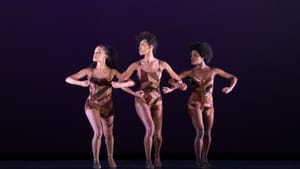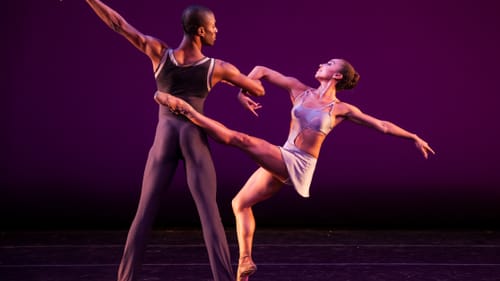Stay in the Loop
BSR publishes on a weekly schedule, with an email newsletter every Wednesday and Thursday morning. There’s no paywall, and subscribing is always free.
Community favorites back in Philly
Annenberg Center Live and NextMove Dance present Dance Theater of Harlem

When the Annenberg’s Christopher Gruits and NextMove’s Randy Swartz put their heads together this year as series co-presenters to choose an artist-in-residence, Dance Theater of Harlem was the obvious choice.
The company shared the presenters’ commitment to community outreach, and Philadelphia has loved it since Swartz presented it at the Walnut Street Theatre during its first touring season (1971-1972). For this year’s residency, the company gave a special performance for students as well as university and high-school master classes, including at the High School for the Creative and Performing Arts (CAPA). The residency concluded with three performances at the Zellerbach.
Caught reaching for the stars
The evening opened with the world premiere of choreographer (and CAPA alum) Robert Garland’s Nyman String Quartet #2. Overall, I found it an uncomfortable piece, which I think is a good thing. Michael Nyman pretty much invented the term minimalism, and his string quartet is marked by frenetic speed and the repetition of short phrases that build over each other, driving the dancers at a pulse-pounding pace. Garland meets the music head on, bringing African and African American-style dance into an edgy discourse with classical technique.
The speed of the music often seemed to constrain the technique. Jetés, for example, did not reach soaring heights but stayed closer to the ground, short and quick as if trying not to get caught reaching for the stars. In a stunning solo, the insistent music slowed for a moment and dancer Da’ Von Doane seemed to curl fluidly in on himself, knees and hips loose, arms weaving in a swimming motion; he seemed to combine writhing angst with a physically self-aware irony that was riveting.
The dancers seemed to struggle against a world too fast, too loud, too frantic to keep up, but broke free in moments of explosive leaps and lifts and hip-swinging challenge. Costumes by Pamela Allen-Cummings (red shorts and sleeveless streaky gray-and-red tees for the men; grey and red tops with filmy white skirts for the women) stood out in Roma Flowers’s dark lighting, heightening the dancers’ onstage dichotomies. I liked this piece, but it will take more thought, and more opportunities to see it performed, to really find my way through it. Which, I suppose, is the most you can ask of art.
Return

The evening ended with a rousing performance of Garland’s 1999 Return, set to the music of James Brown with Alfred Ellis, and Aretha Franklin and Carolyn Franklin. The piece (with costumes by Allen-Cummings that evoked a mod ’60s) pulled out all the stops on technique, with lots of lifts and jetés and arabesques and splits. There were a few classic Balanchine moves that evoked the company’s beginnings, but with that music, there had to be some James Brown moments. The dancers were having fun, moving seamlessly from classical to the pop/funk styles. “Mother Popcorn” had us laughing in our seats, but my favorite had to be the line dance. In my misspent youth I could never have imagined line dancing so well.
Warriors for change
Sitting between the two Garland pieces, Dianne McIntyre’s powerful Change celebrated the resilience and strength of women of color as “warriors for change.” Every part of this dance felt deeply personal. The percussion by Eli Fountain rang like church bells and the songs performed by the Spelman College Glee Club reflected McIntyre’s connection with the college (she was a visiting distinguished scholar there when she created the piece). Costume designer Oran Bumroongchart created the leotards as a patchwork of tights worn by former dancers with the company. The lighting by designer Alex Fabozzi felt too dark at the top, but seemed to bathe the dancers in a bronze glow by the end.
The dance opened to the slow chime of a bell. Two more women in skirts of different lengths joined a third on the stage. The choir music began, and the trio (Lindsey Croop, Yinet Fernandez, and Daphne Lee) took us through the changes of the title. Their arabesques felt thoughtful, as if they were holding up the world on their outstretched legs; then the dancing moved closer to the ground, the dancer’s arms outstretched in anger or supplication. Finally, with their black skirts cast off, they returned with those patchwork leotards in full view. Imbued with the strength of the women who had come before them, they became warriors, their arms bent, shifting their shoulders to thrust out their chests, strong and proud and ready to defend the world. My notes descended into meaningless gushing at this point. It was an amazing piece.
What, When, Where
Dance Theater of Harlem in residence at the Annenberg and NextMove Dance. March 1-2, 2019, at the Zellerbach Theatre of the Annenberg Center, 3680 Walnut Street, Philadelphia. (215) 898-3900 or annenbergcenter.org.
Sign up for our newsletter
All of the week's new articles, all in one place. Sign up for the free weekly BSR newsletters, and don't miss a conversation.

 Camille Bacon-Smith
Camille Bacon-Smith